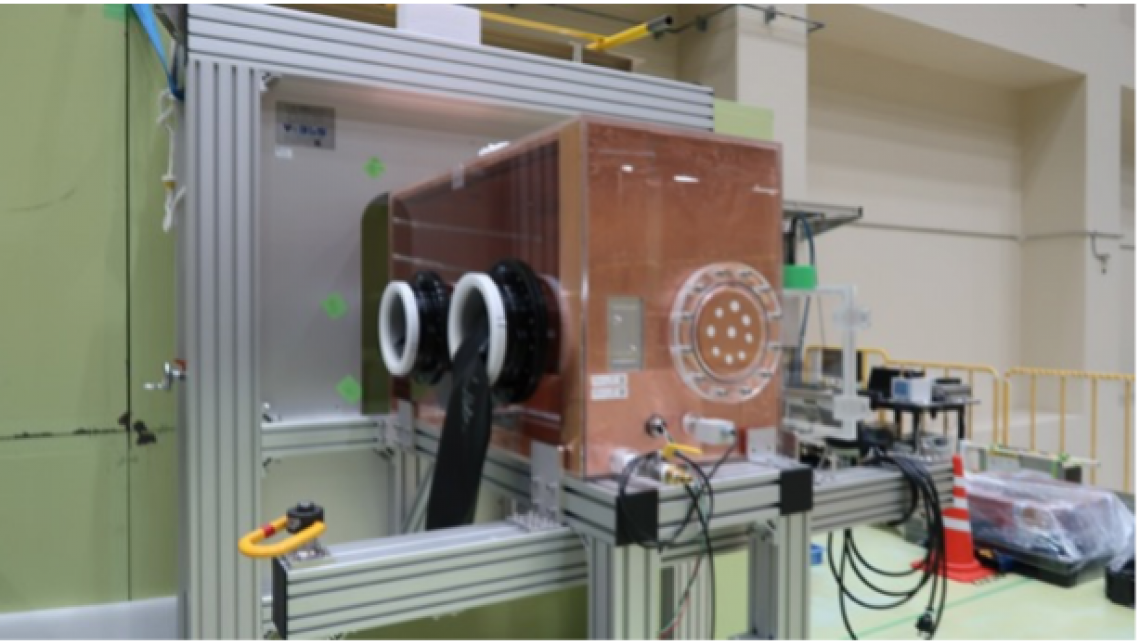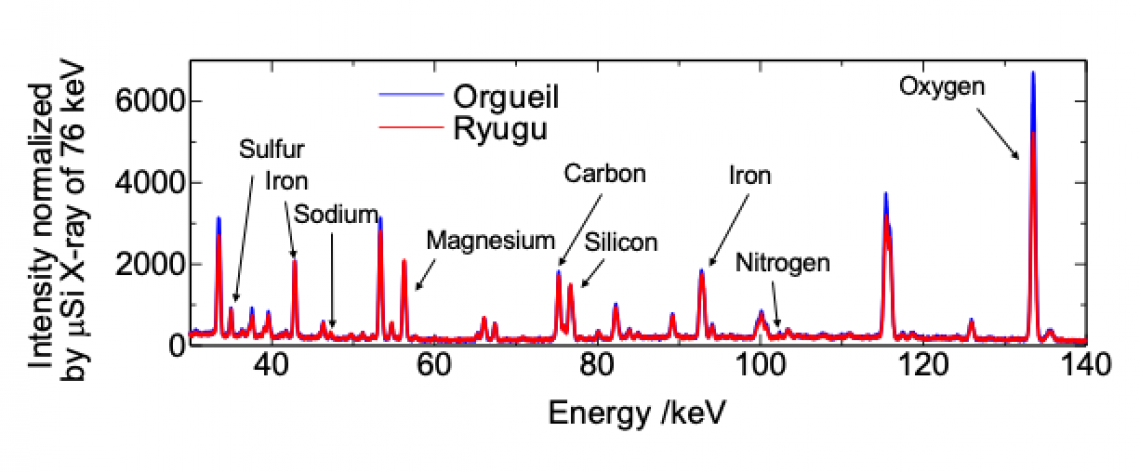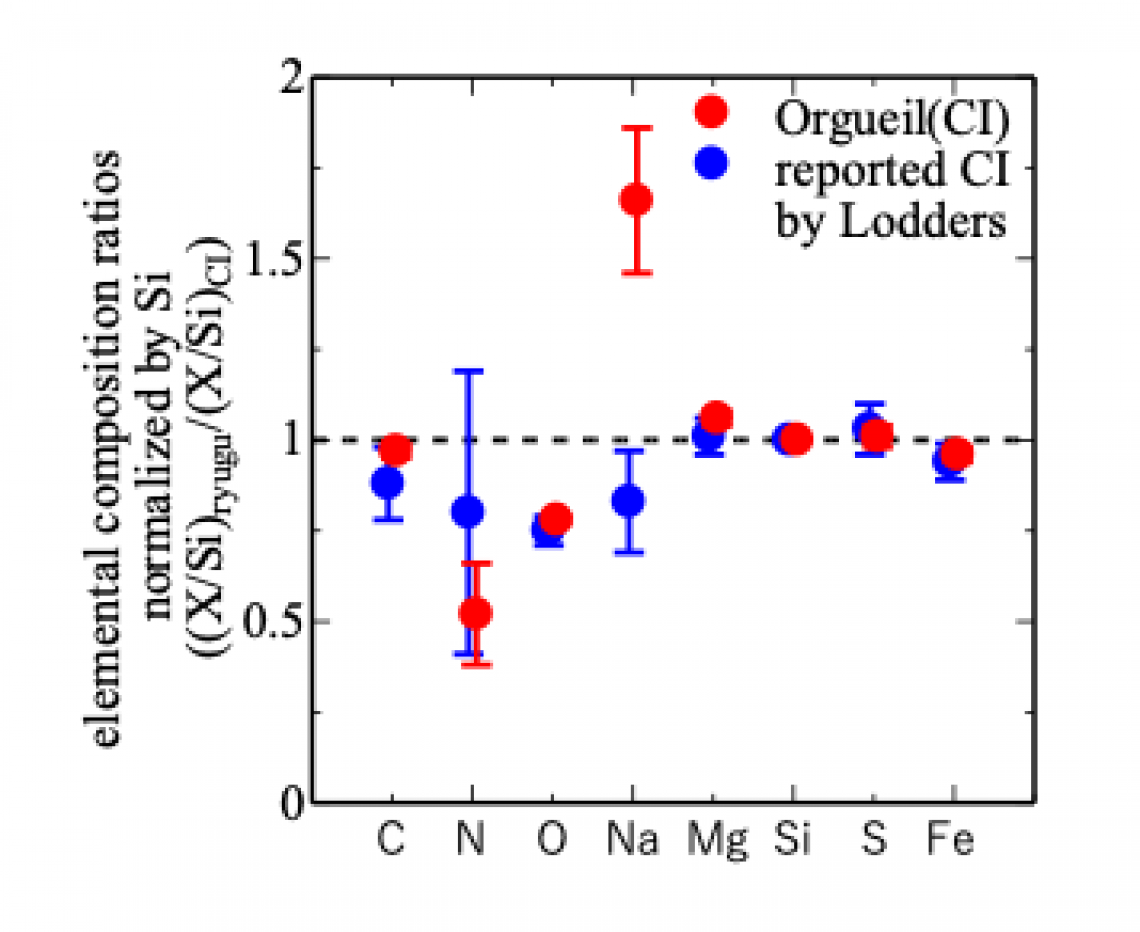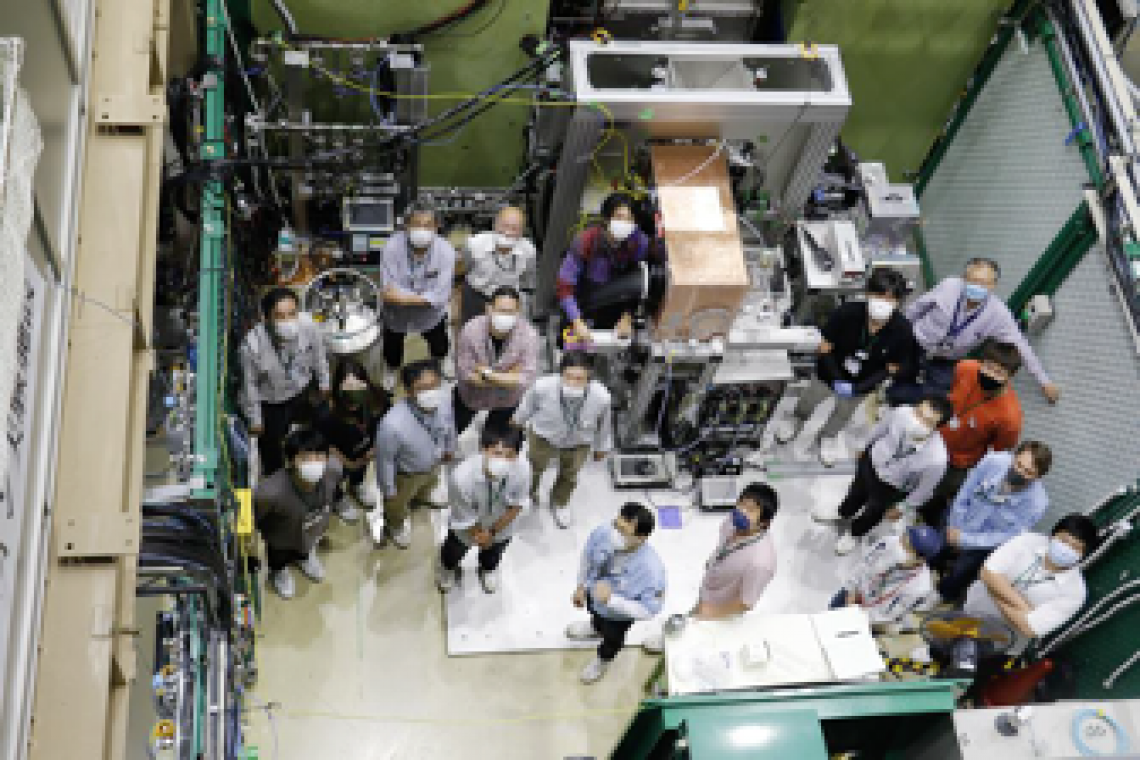Figure 1: (left) A muonic x-ray created after a muon is captured by an irradiated material, and (right) a sample of the asteroid Ryugu.
Stone samples brought back to Earth from asteroid Ryugu have had their elemental composition analyzed using an artificially generated muon beam from the particle accelerator in J-PARC. Researchers found a number of important elements needed to sustain life, including carbon, nitrogen, and oxygen, but also found the oxygen abundance relative to silicon in asteroid Ryugu was different from all meteorites that have been found on Earth, reports a new study in Science.
In 2014, the unmanned asteroid explorer Hayabusa 2 was launched into space by the Japan Aerospace Exploration Agency (JAXA) with a mission to bring back samples from asteroid Ryugu, a type C asteroid that researchers believed was rich in carbon. After successfully landing on Ryugu and collecting samples, Hayabusa 2 returned to Earth in December 2020 with samples intact.
Since 2021, researchers have been running the first analyses of the samples, led by University of Tokyo Professor Shogo Tachibana. Split into several teams, researchers have been studying the samples in different ways, including stone shapes, elemental distribution, and mineral composition.
In this study, led by Tohoku University Professor Tomoki Nakamura, Professor Tadayuki Takahashi and graduate student Shunsaku Nagasawa of the Kavli Institute for the Physics and Mathematics of the Universe (Kavli IPMU), University of Tokyo, in collaboration with the High Energy Accelerator Research Organization (KEK) Institute for Materials Structure Science, Osaka University, Japan Atomic Energy Agency (JAEA), Kyoto University, International Christian University, Institute of Space and Astronautical Science (ISAS), and Tohoku University, have applied elemental analysis methods using negative muons, elementary particles produced by the accelerator at J-PARC. They applied the elemental analysis method using negative muons to stones from the asteroid Ryugu, succeeding in nondestructively determining their elemental compositions.
This was important, because if asteroids in the Solar System were built at the beginning of the formation of the Solar System itself, then they would still be withholding information about the average elemental composition at that time, and therefore of the entire Solar System.
Analysis of meteorites that have fallen to Earth have been carried out in the past, but it is possible these samples have been contaminated by the Earth's atmosphere. So, until Hayabusa 2, no one knew what the chemical composition of an asteroid was for sure.
But the researchers faced a challenge. Because of the limited amount of samples and the large number of other researchers wanting to study them, they needed to find a way to run their analyses without damaging them so that the samples could be passed on to other groups.
The team had developed a new method, which involved shooting a quantum beam, or specifically a beam of negative muons, produced by one of the world's largest high-energy particle accelerators J-PARC in Ibaraki prefecture, Japan, to identify the chemical elements of sensitive samples without breaking them.
Takahashi and Nagasawa then applied statistical analysis techniques in X-ray astronomy and particle physics experiments to analyze muon characteristic X-ray.
Muons are one of the elementary particles in the universe. Their ability to penetrate deeper into materials than X-rays makes them ideal in material analysis. When a negative muon is captured by the irradiated sample, a muonic atom is formed (figure 1). The muonic X-rays emitted from the new muonic atoms have high energy, and so can be detected with high sensitivity. This method was used to analyze the Ryugu samples.
But there was another challenge. In order to keep the samples from being contaminated by the Earth's atmosphere, the researchers needed to keep the samples out of contact with oxygen and water in the air. Therefore, they had to develop an experimental setup, casing the sample in a chamber of helium gas (figure 2). The inner walls of the chamber were lined with pure copper to minimize the background noise when analyzing the samples.
In June 2021, 0.1 grams of Ryugu asteroid were brought into J-PARC, and the researchers ran their muon X-ray analysis, which produced an energy spectrum (figure 3). In it, they found the elements needed to produce life, carbon, nitrogen and oxygen, but they also found the sample had a composition similar to that of carbonaceous chondrite (CI chondrite) asteroids, which are often referred to as the standard for solid substances in the Solar System. This showed the Ryugu stones were some of the earliest stones to have formed in our Solar System.
However, while similar in composition to CI chondrites, the Ryugu sample’s oxygen abundance relative to silicon was about 25 per cent less than that of the CI chondrite (figure 4). The researchers say this could indicate that the excess oxygen abundance relative to silicon in CI chondrites could have come from contamination after they entered Earth's atmosphere. Ryugu stones could set a new standard for matter in the Solar System.
The team’s results show the success of the muonic x-ray method, and that it can be used to analyze samples from future space missions.
Details of this study were published in Science on September 22.
Note 1: The muon experiment was carried out under KEK-MSI Muon Joint Usage Proposals 2019MS01 and was supported by Grant-in-Aid for Scientific Research on Innovative Area (2018-2022), MEXT, Japan "Toward new frontiers: Encounter and synergy of state-of-the-art astronomical detectors and exotic quantum beams" ( Grant number 18H05457, 18H05460, 18H05463, 18H05464).
Note 2: The Muon Analysis Team was formed to perform the muon analysis and belongs to the "Stone Material Analysis Team." Members include: KEK/J-PARC Materials and Life Science Experimental Facility Emeritus Professor Yasuhiro Miyake, Assistant Professor Izumi Umegaki, Assistant Professor Soshi Takeshita, Professor Koichiro Shimomura, Japan Atomic Energy Agency Chief Researcher Takahito Osawa, Osaka University Associate Professor Kazuhiko Ninomiya, Professor Kentaro Terada, Specially Appointed Researcher I-Huan Chiu, University of Tokyo Professor Tadayuki Takahashi, graduate student Shunsaku Nagasawa, Assistant Professor Shin’ichiro Takeda, Project Researcher Miho Katsuragawa, graduate student Takahiro Minami, Kyoto University Associate Professor Akihiro Taniguchi, International Christian University Professor Kenya Kubo, Japan Aerospace Exploration Agency Associate Professor Shin Watanabe, Tokyo University of the Arts part-time lecturer Kazumi Mizumoto, RIKEN Chief Scientist Toshiyuki Azuma, and Tohoku University Professor Tomoki Nakamura and graduate student Taiga Wada.
Figure 2: The custom-made experiment setup developed to avoid the samples from being contaminated by the Earth’s atmosphere. The interior is filled with helium gas, and the chamber is lined with pure copper to minimize background noise.
Figure 3: Muonic x-ray spectral comparison of asteroid Ryugu sample and CI chondrite Orgueil.
Figure 4: Comparison of the elemental composition of asteroid Ryugu sample and CI chondrite Orgueil (K. Lodders, The Astrophysical Journal, 591, 1220-1247, 2003). The oxygen x-ray shows the Ryugu sample’s oxygen abundance relative to silicon was less compared to CI chondrite.







